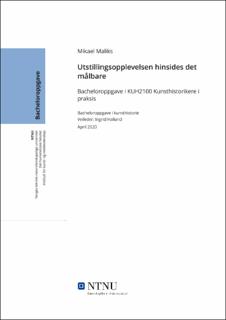| dc.contributor.advisor | Halland, Ingrid | |
| dc.contributor.author | Maliks, Mikael | |
| dc.date.accessioned | 2020-07-25T16:00:54Z | |
| dc.date.available | 2020-07-25T16:00:54Z | |
| dc.date.issued | 2020 | |
| dc.identifier.uri | https://hdl.handle.net/11250/2670229 | |
| dc.description.abstract | Målingshandlingen har de siste århundrene hatt stor betydning for kunnskapsproduksjonen i vestlige samfunn, og på flere måter rettferdiggjort institusjoner slik som museet. Hvordan er kvantifiseringen viktig for formidlingsinstitusjonen, hvor går grensen for den, og kan den virkelig ha definisjonsmakt i opplevelsen av utstilte kunstobjekter? Med utgangspunkt i prosjektsamarbeidet gjort i utstillingen "Beyond Measure" på Trondheim kunstmuseum, og med bakgrunnsinformasjon i oppdragsgiverens inspirasjonskilde, idehistorikeren Jonna Bornemarks "Det omätbaras renässans", skal jeg i denne bacheloroppgaven drøfte tematikken i lys av fenomenologien hinsides det målbare. Oppgavens tittel referer til de to halvdelene i oppgavestrukturen, hvor jeg i den første skal redegjøre for hvordan målingshandlingen produserer sannhet innen institusjonen, dens anvendelse på museet etter krav fra forvaltningsorganer som Kulturrådet, og hvordan installasjonene i "Beyond Measure" gjør oss oppmerksomme på målingens forutsetninger og begrensninger. I den andre halvdelen, skal jeg deretter diskutere hvordan kvantifiseringen oppfordrer til overfladiske og forhastede lesninger av kunstobjekter. Til slutt, som et idehistorisk motsvar til disse lesningene med forankring i begrepsapparatet til Martin Heidegger, skal jeg gi eksempler fra utstillingen, og foreslå mer opplevelsesmessige og tvetydighetsåpne tilnærminger til verkene hinsides det målbare. | |
| dc.description.abstract | The act of measuring has played a major role in the production of knowledge in Western societies in recent centuries, and in many ways justified institutions such as the museum. How is quantification important to the mediary institution, where does its limits go, and can it really have determining power in the experience of exhibited art objects? Based on the project collaboration done in the exhibition "Beyond Measure" at the Trondheim Kunstmuseum, and with background information in the counsellor's source of inspiration, the intellectual historian Jonna Bornemark's "Det omätbaras renässans", I will discuss in this bachelor thesis the theme in light of the phenomenology beyond measure. The title of this thesis refers to the two halves of the task structure, where in the first, I will explain how the act of measurement produces truth within the institution, its application to the museum according to the demands of administrative bodies such as Kulturrådet, and how the installations in "Beyond Measure" make us aware of the requirements and limitations of measuring. In the second half, I will then discuss how quantification encourages superficial and hasty readings of art objects. Finally, as an equivalent to these readings in the history of ideas, with particular emphasis on the conceptual apparatus of Martin Heidegger, I will give examples from the exhibition, and propose more experiential and ambiguous approaches to the works beyond measure. | |
| dc.publisher | NTNU | |
| dc.title | Utstillingsopplevelsen hinsides det målbare | |
| dc.type | Bachelor thesis | |
